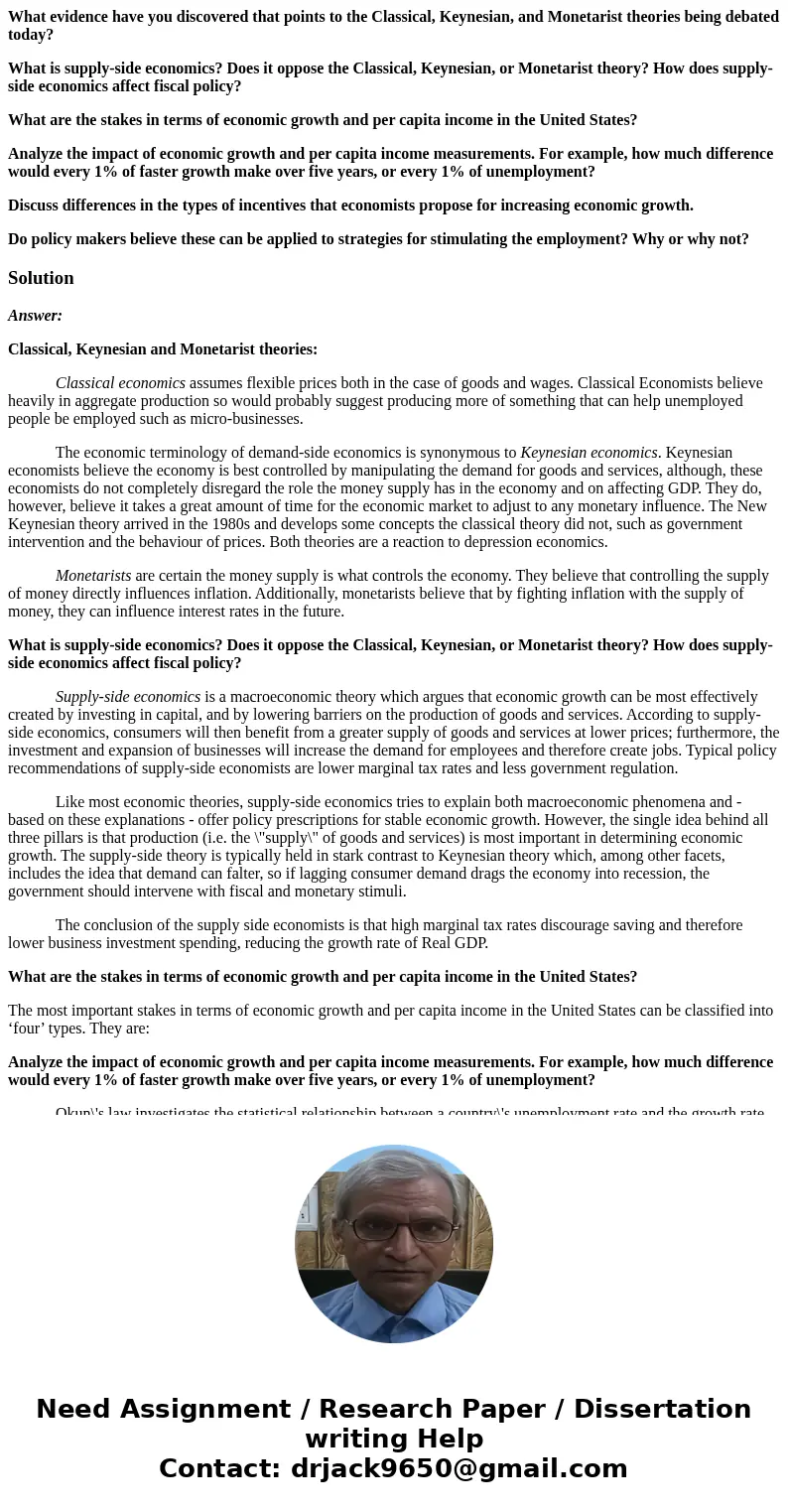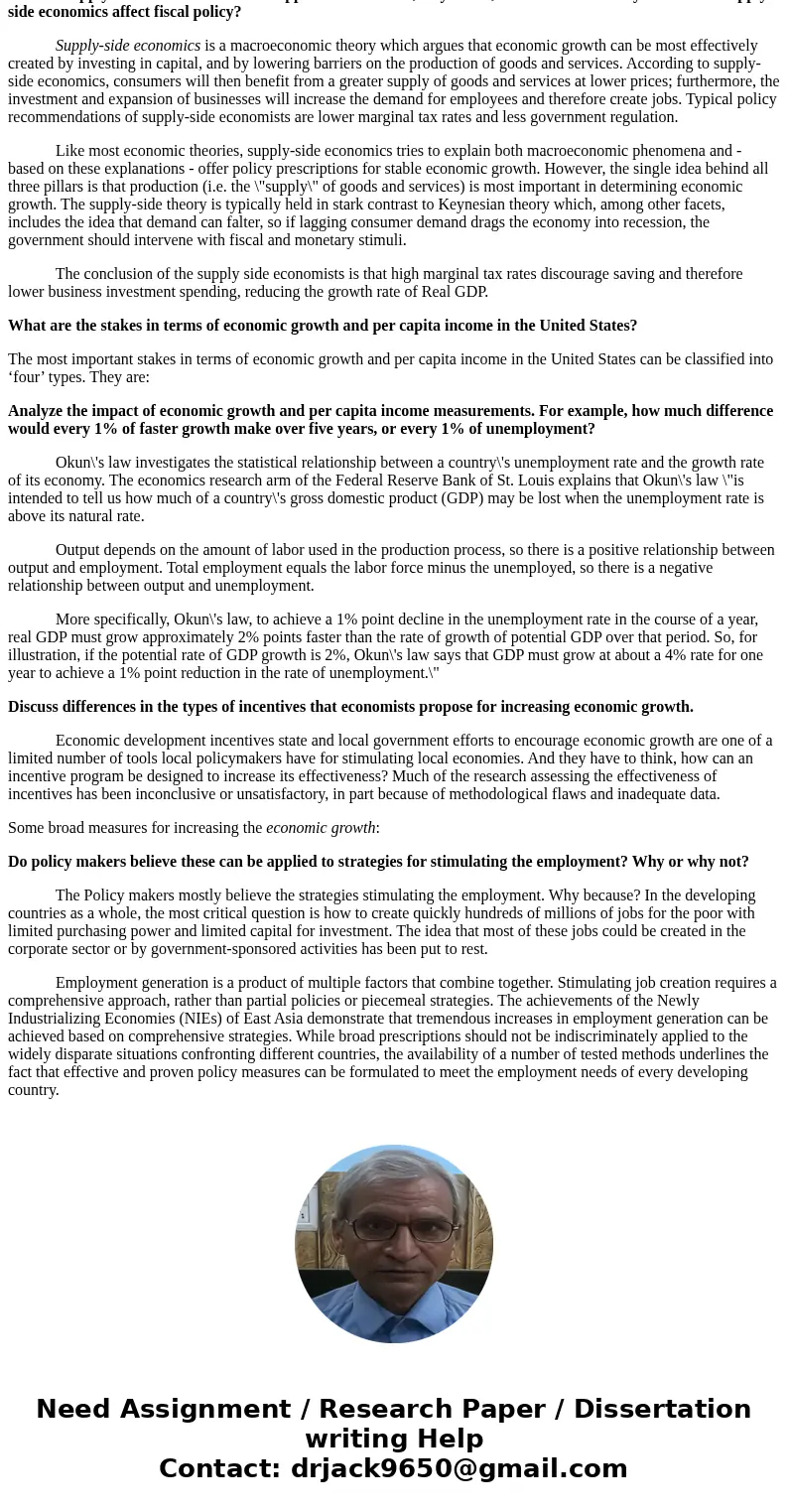What evidence have you discovered that points to the Classic
What evidence have you discovered that points to the Classical, Keynesian, and Monetarist theories being debated today?
What is supply-side economics? Does it oppose the Classical, Keynesian, or Monetarist theory? How does supply-side economics affect fiscal policy?
What are the stakes in terms of economic growth and per capita income in the United States?
Analyze the impact of economic growth and per capita income measurements. For example, how much difference would every 1% of faster growth make over five years, or every 1% of unemployment?
Discuss differences in the types of incentives that economists propose for increasing economic growth.
Do policy makers believe these can be applied to strategies for stimulating the employment? Why or why not?
Solution
Answer:
Classical, Keynesian and Monetarist theories:
Classical economics assumes flexible prices both in the case of goods and wages. Classical Economists believe heavily in aggregate production so would probably suggest producing more of something that can help unemployed people be employed such as micro-businesses.
The economic terminology of demand-side economics is synonymous to Keynesian economics. Keynesian economists believe the economy is best controlled by manipulating the demand for goods and services, although, these economists do not completely disregard the role the money supply has in the economy and on affecting GDP. They do, however, believe it takes a great amount of time for the economic market to adjust to any monetary influence. The New Keynesian theory arrived in the 1980s and develops some concepts the classical theory did not, such as government intervention and the behaviour of prices. Both theories are a reaction to depression economics.
Monetarists are certain the money supply is what controls the economy. They believe that controlling the supply of money directly influences inflation. Additionally, monetarists believe that by fighting inflation with the supply of money, they can influence interest rates in the future.
What is supply-side economics? Does it oppose the Classical, Keynesian, or Monetarist theory? How does supply-side economics affect fiscal policy?
Supply-side economics is a macroeconomic theory which argues that economic growth can be most effectively created by investing in capital, and by lowering barriers on the production of goods and services. According to supply-side economics, consumers will then benefit from a greater supply of goods and services at lower prices; furthermore, the investment and expansion of businesses will increase the demand for employees and therefore create jobs. Typical policy recommendations of supply-side economists are lower marginal tax rates and less government regulation.
Like most economic theories, supply-side economics tries to explain both macroeconomic phenomena and - based on these explanations - offer policy prescriptions for stable economic growth. However, the single idea behind all three pillars is that production (i.e. the \"supply\" of goods and services) is most important in determining economic growth. The supply-side theory is typically held in stark contrast to Keynesian theory which, among other facets, includes the idea that demand can falter, so if lagging consumer demand drags the economy into recession, the government should intervene with fiscal and monetary stimuli.
The conclusion of the supply side economists is that high marginal tax rates discourage saving and therefore lower business investment spending, reducing the growth rate of Real GDP.
What are the stakes in terms of economic growth and per capita income in the United States?
The most important stakes in terms of economic growth and per capita income in the United States can be classified into ‘four’ types. They are:
Analyze the impact of economic growth and per capita income measurements. For example, how much difference would every 1% of faster growth make over five years, or every 1% of unemployment?
Okun\'s law investigates the statistical relationship between a country\'s unemployment rate and the growth rate of its economy. The economics research arm of the Federal Reserve Bank of St. Louis explains that Okun\'s law \"is intended to tell us how much of a country\'s gross domestic product (GDP) may be lost when the unemployment rate is above its natural rate.
Output depends on the amount of labor used in the production process, so there is a positive relationship between output and employment. Total employment equals the labor force minus the unemployed, so there is a negative relationship between output and unemployment.
More specifically, Okun\'s law, to achieve a 1% point decline in the unemployment rate in the course of a year, real GDP must grow approximately 2% points faster than the rate of growth of potential GDP over that period. So, for illustration, if the potential rate of GDP growth is 2%, Okun\'s law says that GDP must grow at about a 4% rate for one year to achieve a 1% point reduction in the rate of unemployment.\"
Discuss differences in the types of incentives that economists propose for increasing economic growth.
Economic development incentives state and local government efforts to encourage economic growth are one of a limited number of tools local policymakers have for stimulating local economies. And they have to think, how can an incentive program be designed to increase its effectiveness? Much of the research assessing the effectiveness of incentives has been inconclusive or unsatisfactory, in part because of methodological flaws and inadequate data.
Some broad measures for increasing the economic growth:
Do policy makers believe these can be applied to strategies for stimulating the employment? Why or why not?
The Policy makers mostly believe the strategies stimulating the employment. Why because? In the developing countries as a whole, the most critical question is how to create quickly hundreds of millions of jobs for the poor with limited purchasing power and limited capital for investment. The idea that most of these jobs could be created in the corporate sector or by government-sponsored activities has been put to rest.
Employment generation is a product of multiple factors that combine together. Stimulating job creation requires a comprehensive approach, rather than partial policies or piecemeal strategies. The achievements of the Newly Industrializing Economies (NIEs) of East Asia demonstrate that tremendous increases in employment generation can be achieved based on comprehensive strategies. While broad prescriptions should not be indiscriminately applied to the widely disparate situations confronting different countries, the availability of a number of tested methods underlines the fact that effective and proven policy measures can be formulated to meet the employment needs of every developing country.


 Homework Sourse
Homework Sourse